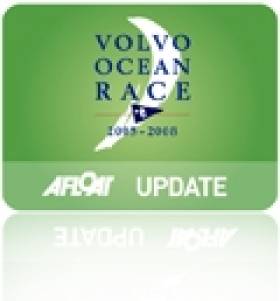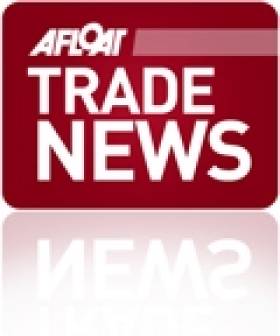Displaying items by tag: Boot
Dubarry 'Crosshaven' Was Born at Sea Onboard Ireland's Green Dragon
#dubarry – During their gruelling experiences throughout the Volvo Ocean Race 2008/9, the crew of the Irish entry, Green Dragon, had modified a 'workshop enhanced' version of Dubarry's existing performance sailing boot 'Fastnet' by adding a fairly crude, improvised integral gaiter. On their return to Galway, Green Dragon crew members Ian Walker, Neal McDonald and Damian Foxall, along with key onshore support personnel, met with the Dubarry Design and Engineering team led by Design Director Brian Geraghty. Their 'enhanced' boot was the subject of extensive examination and discussions that enabled Dubarry to garner a very detailed understanding of what sailors demand when working in the most extreme conditions imaginable. It was from these meetings with those that know, love and respect the ocean that the Crosshaven concept was conceived.
Crosshaven's most striking feature is the integral gaiter. It is made with a lightweight, high abrasion, water repellant fabric with an adjustable draw-cord collar that secures foul weather gear and prevents wash back. It also houses a drainage mesh for optimal water release and features high-visibility bands. It is thermally insulated, utilising a 350g GORE-TEX® Duratherm membrane for extra warmth and waterproofness, combined with a thermally-lined footbed, which provides the boot with full insulation. Reinforced toe and heel parts utilise Dubarry's unique D-Chassis System. This two-part foot support system is inspired by Formula 1 racing technology and uses a moulded RPU frame that minimizes heel pronation by adding extra support, protection and control.
Crosshaven also has finger pulls for easy foot entry and ExtraFit™ sizing. The inner leg is constructed of Dubarry's DryFast-DrySoft™ leathers and Cordura®. These features, combined with our award-winning NonSlip-NonMarking™ durable outsole, make this a very special, ultra high-performance sailing boot indeed.
Crosshaven has gone on to become the sailing boot of choice for top crews across the globe, including Team Telefonica and Abu Dhabi Ocean Racing in VOR 2011/12, and is currently at sea in the 2014/15 race on a number of boats including Team Brunel.
boot Düsseldorf 2013 is Marine Industry Choice as German Watersports Market Still Buoyant
#bootdusseldorf – The World's biggest yacht and watersports show is well on course for another successful showing ealry next year with boot Düsseldorf proving to be a safe haven in turbulent economic times. The yacht and watersports industry is concentrating its trade fair activities increasingly on the sector's international marketplace and filling the exhibition halls there. 1,650 exhibitors from over 50 countries will be premiering boats and presenting new products at the world's biggest yacht and watersports show from 19 to 27 January 2013. boot 2013 looks all set to pick up where its successful predecessor left off.
"We're well on course. In view of the tense situation on the international markets and particularly in southern Europe, all eyes of the industry are now on boot," says Goetz-Ulf Jungmichel, Director of boot Düsseldorf. "Numerous exhibitors want to book extra space. We are confident that the 17 boot halls will be filled pretty well to capacity and expect plenty of innovations and boat premieres and even a number of new arrivals from the international yacht scene."
The German boat and watersports market is currently "standing firm", according to the German Marine Federation (BVWW) in Cologne. It is proving to be in a much stronger state than its European neighbours, which applies particularly to the Mediterranean region strongly affected by the European debt crisis. boot Düsseldorf is benefiting from this scenario and has become the industry's premier choice.
Exhibitors are pinning their hopes on a continuation of German consumers' buying mood and on the roughly 50,000 foreign visitors with money to spend who travel to boot Düsseldorf from all over the world every year to find out all about the latest innovations in the boat and yacht sector.
International brand diversity
Roughly 40 per cent of those participating in boot 2013 will be coming from outside Germany. Some 650 foreign exhibitors from well over 50 countries are contributing to the highly international quality of what's on show at the trade fair centre. The biggest foreign contingent is the Netherlands with 140 exhibiting boatyards, equippers and service providers, followed by France and Italy each with 50 exhibitors, the United Kingdom with 30 and Austria 26.
International brand diversity is being bolstered by joint participations of leading boatbuilding nations. The UK, Finland, France, the Netherlands, Poland and Hungary have registered with joint stands.
Magnificent selection of sailing vessels
According to the BVWW, customers are currently showing a preference for value-retaining upmarket motor and sailing yachts. But there is also demand for trailerable motor boats. At boot 2013, the customer has a huge choice. In 11 exhibition halls, 440 exhibitors will be showing some 1700 boats and yachts of all sizes, ranging from canoes to large luxury yachts.
There is a magnificent selection of sailing boats under the boot 2013 umbrella. Over 150 international exhibitors will be presenting their premieres and further-developed products in Halls 16 and 17. Devotees of multihull vessels should make a detour to neighbouring Hall 15 where 15 exhibitors will be showing catamarans and trimarans of all sizes. The small but select segment of multihulls has come along very well in the last two years and is being given its own food & drink area at boot 2013, which will also offer space for meetings with customers and exchanges of information. On the Multihull Forum stage, the German association of multihull sailing boats Multihull Deutschland e.V. will be presenting information on sailing with catamarans and trimarans.
World market for motorised leisure boating
In the motor boat and motor yacht sector, Düsseldorf is offering almost everything that's available on the market, ranging from inflatable boats with outboard motors via open sports boats, day cruisers and cabin cruisers to large yachts. In a total of six halls, more than 250 boatyards, brokers and importers will be providing a representative overview of motorised leisure boating. Hall 4 is responding to the trend towards environment-friendly drives. On an area of 1600 square metres, boats with electric and hybrid drives will be on show at boot 2013. Steel yacht building, a Dutch speciality, is being jointly presented by a total of 20 exhibitors in Hall 15.
Run on refits
Everything one needs for and on boats – marine electronics, engines, accessories, functional clothing and marina equipment – can be found in Halls 11 and 12. The equipment market is in excellent shape. "Refit" is the buzz word, and there is currently strong interest in maintaining the value of existing boats. 350 international exhibitors are offering everything that's necessary and possible for smartening up boats and furnishing them more luxuriously.
Curtain up for large yachts
Hall 6 is the dazzling showcase for large, luxury yachts. For the big names in the world of large yachts – the likes of Ferretti, San Lorenzo, Princess and Riva – there's no alternative to boot Düsseldorf even in difficult times. With some 40 large yachts coupled with high-end boats and tenders plus a number of first-time and returning exhibitors, the standard of offering in large yacht Hall 6 has clearly stabilised. The new and established participants include such boatyards as Montefino, Marquis Yachts and Prestige. In the extra-large yacht sector, Sunseeker, Princess, Acico and Ferretti will be entering the stage with a broad array of models and novelties. The biggest yacht at boot 2013 is roughly 30 metres long and comes from the UK-based Princess boatyard.
To enhance brand diversity, boot is offering its customers the chance to present themselves at image stands. Leading boatyard exhibitors like Mangusta and Dominator from Italy and Gulcraft from the United Arab Emirates are seizing the opportunity. Computer-aided applications like augmented reality, with the aid of which exhibited items such as yacht models or images can be supplemented with virtual yacht animations via smartphone cameras, can be used in this form of "yachtless" presentation to supplement the existing range of information.
The blue motion lounge in Hall 6 is available to high-calibre customers from the industry as a business and shopping zone. It comes with high-quality catering, comfortably furnished areas for meetings with customers and negotiations, and shopping opportunities in exclusive boutiques. Exhibitors from the luxury retail trade will be present with jewellery, watches and exclusive interior decoration.
Excellently booked, as always, is Düsseldorf's Superyacht Show in Hall 7a. 100 exhibitors will be demonstrating their skills in the realisation of exclusive yachtbuilding projects, showing current plans and models at information stands and reporting on sector-specific services. The joint exhibitors here include Deutsche Yachten, Superyacht France and the Holland Yachting Group.
High level of bookings for diving
The world's biggest scuba diving show under the boot umbrella in Hall 3 is recording lively interest. Overall, some 350 exhibitors will be presenting diving equipment and diving destinations worldwide. Big-name exhibitors from the equipment sector like Aqua Lung are extending their presentations, and Mares is coming with its international diving centres to Düsseldorf. Visitors can expect marked growth in the offering of the trade and an abundance of exciting scuba diving destinations. On large joint stands, the Philippines, Maldives, Indonesia and Italy will be publicising their qualities as diving destinations. Small diving bases from Egypt are presenting themselves under the taucher.net umbrella.
Underwater photography now supplemented by the Watersports Photo and Video Center
The theme of underwater and outdoor photography in Hall 4 has developed very well. The Underwater Pixel World will be known as the Water Pixel World at boot 2013. This successfully established forum for underwater photography is now being supplemented by the Watersports Photo and Video Center with its brand-new action and outdoor cameras and will thus become the point of convergence for the entire leisure and sport photography world.
Experience 360° of watersports: 16 theme and adventure worlds
Under the motto "Experience 360° watersports", 16 theme and adventure worlds will await boot visitors next January. Those who practise watersports – anglers, surfers, kiters, divers, sailors paddlers or charterers – or wish to get to know a watersport will find their own special "world" at boot Düsseldorf.
This concept has been very well received. The numerous opportunities for trying out watersports in the exhibition halls attracted more young people and families to boot in the last three years.
boot 2013 will be offering international visitors this and more from 19 to 27 January daily from 10 am to 6 pm. Visitors can save time and money by purchasing boat admission tickets online. As a one-day ticket, the eTicket for adults costs EUR 14, EUR 4 less than over the counter. The two-day ticket is available for EUR 23. The ticket for a quick stroll through the exhibition centre – Monday to Friday from 3 pm – costs EUR 9 in the online shop. The tickets can be printed straight after purchase and used for free travel to and from the fair via the public transport network VRR (Verkehrsverbund Rhein-Ruhr). Tickets are available at www.boot.de.






























































